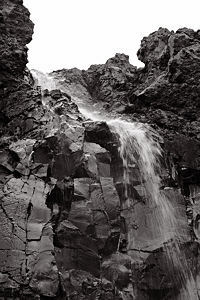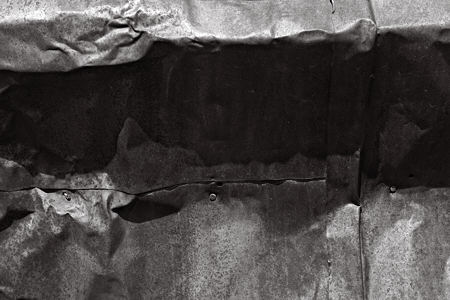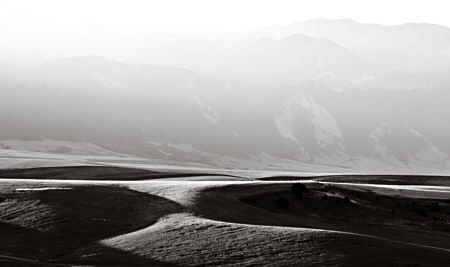 Yesterday I hiked up a mountain for a fabulous view of snow-covered peaks and dark green valleys for many, many miles in all directions. The only photographs I made were of a waterfall on the way up. The surprise is that I made any at all. Despite — or more likely because of — the clichéd nature of the subject, until a year ago I had essentially no waterfall pictures, even of locations I’d visited multiple times, with camera, where I more recently did make photos. Now I have half a dozen or so waterfalls, and I realize it has become a theme. So I want to start looking at them and thinking about them, learning from them.
Yesterday I hiked up a mountain for a fabulous view of snow-covered peaks and dark green valleys for many, many miles in all directions. The only photographs I made were of a waterfall on the way up. The surprise is that I made any at all. Despite — or more likely because of — the clichéd nature of the subject, until a year ago I had essentially no waterfall pictures, even of locations I’d visited multiple times, with camera, where I more recently did make photos. Now I have half a dozen or so waterfalls, and I realize it has become a theme. So I want to start looking at them and thinking about them, learning from them.
Archives for photography
A year of waterfalls
Quotidian art

Two recent blog entries, one by Paul Butzi (I’ve been riffing off him a lot lately) on photographing “Close To Home,” and Birgit’s “Dune Quest” have got me thinking about the notational aspects of artmaking. Namely, the daily investigation of ideas and how that relates to projects of “greater” importance.
Dune Quest
I tried out my new camera along one of the beaches at Sleeping Bear Dunes. Cotton wood trees survive here in the migrating sand because they can grow new root systems higher up on their stems as needed.

Orientation

I revisited one of the places I like to photograph and came back with, among others, the image shown above. No, it was not the scene of junkyard treasure, and this is not the side of a beat-up old car. It’s actually from my ghost town site, and it’s the side of a beat-up old outhouse. I guess I took it because I tend to like abstracts like this. Though that’s probably not the whole story, because this is the only abstract I made in hours of photographing in a place loaded with weathered wood, ancient mining equipment, etc. Perhaps I was drawn to it through mysterious workings of my unconscious. If so, I discovered why the next day — but maybe you can guess it now?
In the absence of sand dunes

Funny how things come together sometimes. After casting about for a while, rejecting various topic possibilities, I finally settled on one I’d had in mind for some time, although I hadn’t prepared images or written anything. After typing the title and while I was uploading images, I noticed Doug had just posted on influence. In part, this post is about what I can do here in Montana that is as much as possible like those fabulous images of California dunes (Oceano, Death Valley) by the Westons and many others (see examples here and here). I’m not exactly striving to copy, but I am deliberately letting that influence wash over me and through me. I love the forms of those high contrast black and white images, both the three-dimensional dune forms and the two-dimensional shapes in the plane. I look at those images often.
But there is another goal with my series, although I had not quite formulated it sharply until Birgit’s recent post. In addition to the dune-like undulating fields in the foreground, most of these images have the Bridger mountains in the background. But the mountains are serving not so much as subject as to bring out the light-filled air of early morning.
Process by elimination
“A photographer is like a cod, which produces a million eggs in order that one may reach maturity.”
–George Bernard Shaw
Photographers are a profligate, wasteful bunch. Maybe not those 4×5 guys, where it takes so much effort to decide to take one picture, but I’m a 35mm guy. I don’t understand large format; it’s a different animal entirely. For me the singular unit is the roll, not the frame. I learned my craft in the era of roll-it-yourself film in reusable cassettes. I found my voice by photographing over, and over, and over again, until I figured it out, in a manner that made it affordable.
I have structured my entire creative process around this unique feature of the photographic process. I shoot in order to find out what it is that is compelling to me. The actual act of operating a camera is how I access the state of consciousness from which my photographs emerge. The more complex the environment I am working in, the more that I can depend on my unconscious mind to find the coherent, complete image.
An aside: In the digital realm, the last barriers to restraint when shooting are pretty much history. Unless you give into temptation, and watch the LCD screen. Seeing your pictures while you’re shooting them is a sure way to interrupt and defeat the process of deepening a connection with the moment. The editing brain is a different one than the shooting brain. It defeats the point to mix them up.
When I’m shooting I don’t know where in the process I’ve “got it”. But I do know when I’m done. Somewhere in there, while I was in that altered state of consciousness, I can sense that it happened. Where precisely, I don’t know. I have to figure that out later.
That “later” process doesn’t get enough attention. Somehow you have to decide which egg you’re going to allow to hatch. It requires a degree of removal from the act of conception, to witness and judge the work for the formal qualities that exist only in the image, and not in your memory of the moment. Henry Wessel, a photo hero of mine, takes it to an extreme unmanageable for most of us. He waits a year to review his work before deciding what to print.
Back in the darkroom days, I’d scan my contact sheets to see which images had some promise, and I’d make work prints. I’d post the prints in the kitchen on a big bulletin board for a few days. It’s one thing to study and consider the work—it’s another to see them in your peripheral vision without knowing you’re looking at them. I’d gradually weed out the prints that were starting to bore me, until there were one or two survivors. These were what I would work on deeper, in the darkroom, to see what potential they held.
I’m still working on the best way to bring this editing process into the digital age. For most of my output my only encounter with the image is on a computer screen. It is not a friendly environment for either a considered, or an unconscious judgement process. Sometimes I’ll go through the effort of making work prints, just like the old days, but it’s harder. It feels removed from something intrinsic to the digital process, and I haven’t found the analogous replacement for the editing mode. I’ll report again in six months and tell you what I’ve figured out.


